On a lot of mountain roads in France it is a legal requirements to carry snow chains with you, and while proper Winter tyres make a lot of difference on snowy and icy roads, they will only get you so far (especially on big heavy two wheel drive vehicles like motorhomes!)
Continue readingTag: Motor Home (page 1 of 5)
Note this article is based around late 90’s to mid 00’s Hymer A-class vans, specifically our 1999 Hymer B544.
Hymer Motorhomes have a bit of a reputation for quality build and being able to out-last many of the other Marques available. Our van is 20 years old at the time of writing and has covered over 220,000km, and whilst it has generally been good to us there are still many things that have needed attention over the years – here’s a list of all the issues with our bus, so you can look out for the same problems if you are looking for a similar vehicle! There are also links to articles on fixing some of the issues.
Continue readingThe Fiat Ducato, Citroen Relay/Jumper and Peugeot Boxer vans together account for the basis of nearly 75% of all motorhomes manufactured in Europe. Each of these vans are nearly identical apart from the finishing trim, as they are all built in the same factory and to the same design as part of a joint venture between Fiat and Peugeot/Citroen (the joint venture is the SEVEL company).
Continue readingWe recently had another issue with our 20 year old motorhome fridge – on arriving at an aire in France the fridge gas burner would not light, and with no electric hook-up available we had no other option than running it on gas.
Continue readingIn order to get to the lower fridge vent on many Hymer models with a rear kitchen it is necessary to remove the rear bumper – here’s how to do it on a late 90’s-early 00’s model

On some models there are fixing screws behind the lights and number plate – but not on this one, so no need to remove anything from the bumper
The bumper is held onto the rear of the van with screws along the top edge and down the side, mostly hidden under a flexible trim strip
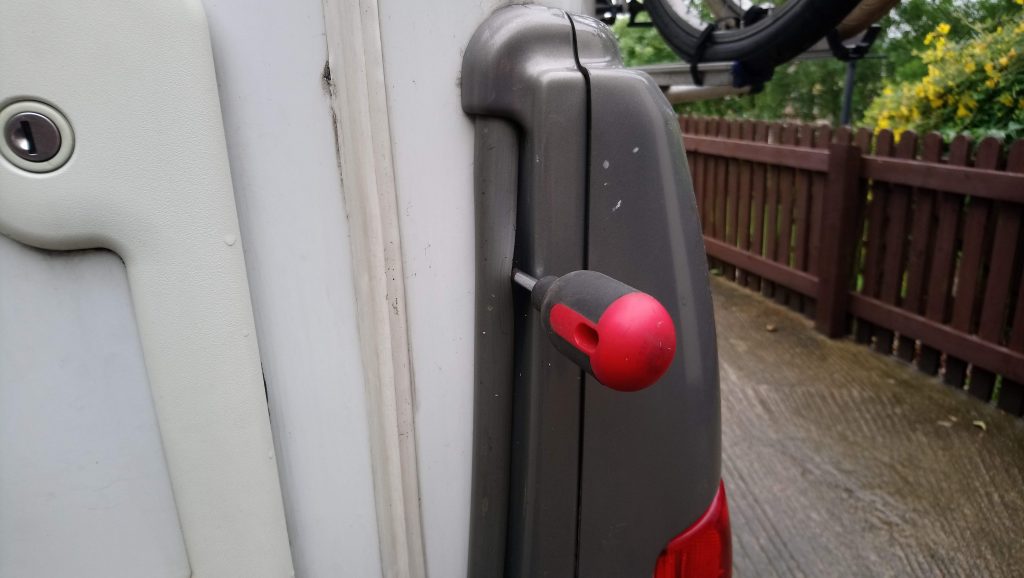
There are typically two screws under the vertical trim strip on either side of the bumper…..

…..and a number of screws underneath the horizontal trim strip across the back of the bumper

There is also a screw on each bottom corner through the plastic of the bumper into the aluminium body
Note – it is useful to have some help on hand to hold the bumper while you remove the last of the screws, as with them removed there is nothing to stop the bumper falling off the back of the van!

The bumper can’t be removed completely without disconnecting the wiring for the lights, but by placing something underneath it to support it you can lower it out of the way to expose the fridge vent with the wiring still attached – as shown here
For details of how to clean/service the burner on the fridge, click here
Found this information useful? – Want to support Motor-Roam?
Click here to find out how!
The three-way fridges fitted to most motorhomes and camper vans are great when they work, but the gas burned and flue assembly can get blocked up with soot and other detritus over time, reducing the fridges effectiveness. Thankfully on most vans the burner can be serviced via the two vents on the outside of the van, so there is no need to remove to the fridge entirely – here’s how…..
(Note – the fridge in this example is a Electrolux RM4410 from the late 90’s, the burner/flue assembly is similar on most Electrolux/Dometic models)
Disclaimer – any gas appliance is obviously dangerous if not it proper working order. The information here is provided for interest only, do not attempt any work on your gas appliances if you are not suitably confident or qualified!

First step is to unclip the plastic cover over the gas flue on the right hand side of the upper vent (hopefully your vent is cleaner than this one!)

With the flue cover removed you will see the flue grille itself, as shown here. Next release the clip on the left hand side of the vent (it slides upwards on this model) and pull the left hand side towards you. Unclip the vent from the tab on the right had side and remove it completely. The flue grille can be lifted out once the vent is removed.

You will now have access to the top section of the rear of the fridge though the vent frame

The top of the flue will have an angled section to direct gasses out of the flue grille, and possibly a flue extension. Loosen the screw closest to the heater can body and remove the top section of the flue. You should now see a small piece of wire hooked over the top of the remaining section of flue – this holds the baffle in place. Using the wire to lift the baffle out of the flue.

Here is the removed upper flue section and baffle – these can now be cleaned if they have a lot of soot on them.
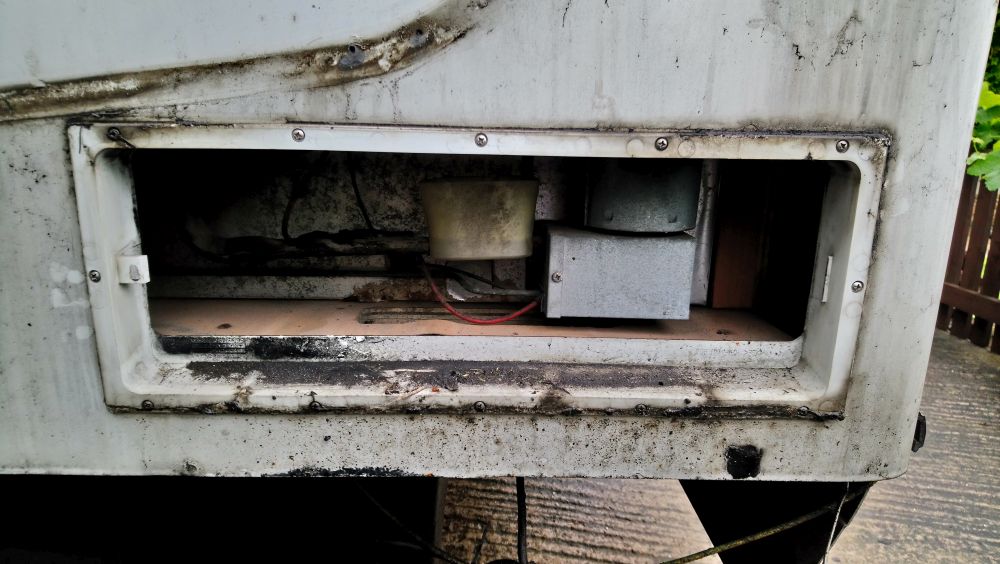
Next step is to remove the lower vent – procedure is the same as the upper vent. The burner heat shield now needs to be removed – it is the small metal box at the bottom of the heater can and is held in place with two small screws.

You should now be able to see the burner as shown here. If you are just cleaning the flue then you can move it out of the way by removing the one screw that holds it onto the flue. If you want to clean the burner out you will need to disconnect the gas pipe from it and undo the clamp bolt that holds the ignitor electrode and thermocouple in place.

Looking in through the top vent you can see the top of the flue, with this access and the burner removed from the bottom of it you can now sweep it out.
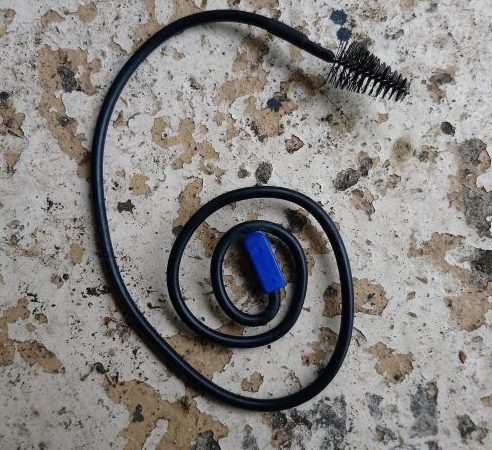
I found a small bottle brush ideal for sweeping out the flue – simple feed it into the flue from the top and keep going until it pops out of the bottom. This brush was sold as a sink drain cleaning device – if you don’t have anything like this you can use electrical cable with the ends frayed out to make your own brush,

This was the result after sweeping out the flue – it’s only a small flue but you can see a lot of soot came out of it!
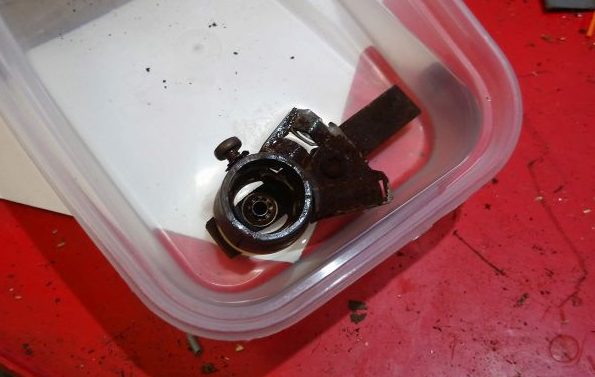
If there is any dirt build up on the burner it is a good idea to clean it up while it’s out. Here it is soaking in Acetone – brake cleaner or similar would also work well. Give it a blow out with a air gun and make sure it is completely dry before reassembly.

Here you can see the gas jet (which is just a metal disc with a tiny hole in it inserted into the end of the burner). As the jet is so small it is prone to getting blocked, you can see ours had some deposits on it. If required replacement jets are available online.

With everything back together you can test it out, with the fridge lit you should have a nice bright blue flame – a yellow flame indicates a lack of air and potential soot/carbon monoxide formation.
We were having issues with the flue gas smelling and soot formation on the top vent – having performed this service we got rid of these problems and got better cooling performance as well!
Found this information useful? – Want to support Motor-Roam?
Click here to find out how!
Note – the lower fridge vent is behind the rear bumper on some motorhome models – here is a post on removing the rear bumper for access on a 1999 Hymer B544
There are various products specifically designed to clean grey water tanks and help stop the nasty smells that can often come out of your plugholes – usually when driving. There are also a plethora of personal remedies available on the internet – cheap cola or orange squash down the plugholes are some of the more ingenious.
While the commercial ‘tank cleaner’ products undoubtedly work, they are expensive and often only work for the time you have them in the tank – smells can quickly return once drained and used again.
The most effective cheap remedy we have found is scented bleach tablets – available for less then 2 Euros for 48 tablets from most French supermarkets:-
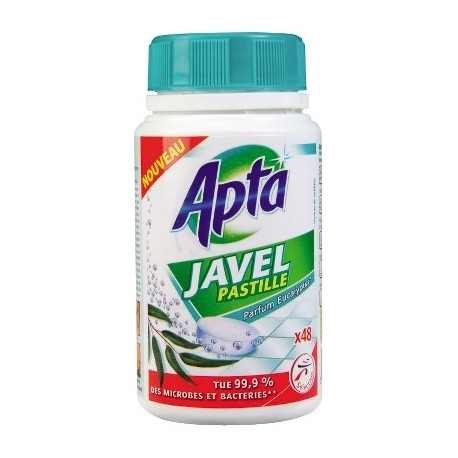
These kill any nasty bacteria living in you grey water tank and leave the grey water smelling clean – think the slight chlorine smell of swimming pool water mixed with a hint of eucalyptus!
Simply let one dissolve in a sink full of water before draining into the tank, or alternatively put one into the shower drain like a urinal biscuit and let it dissolve while you shower.
Do you have any other tried and tested solutions? – let us know in the comments below…
Les Rousses is a small ski resort in the Haut Jura region on the Frace-Switzerland border with 48km of Pistes. There is dedicated motorhome parking at the bottom of the Balancier chairlift with a Flot Bleu terminal for fresh water and waste discharge.
Continue readingThe Valloire ski area is linked to Valmeinier and offers 150km of pistes. There is a serviced & barrier controlled Aire at the bottom of the Les Verneys chairlift that costs around 13 Euro per night and includes water/waste/power/WiFi. (There is a power connection for each spot, limited to 6 Amps)
Continue readingSaw this recently on a van next to me in a ski resort car park – clever modification of a rear mounted bike rack to carry skis:-

It’s a set of standard, universal ‘gutter mount’ roof bars clamped to the bike carrying channels (the bars have been cut down to suit) Standard roof-bar ski carriers are then mounted to the bars, simple and cheap solution to carrying skis!
This approach could also be extended to anything designed to mount to roof bars, providing you don’t exceed the weight limit of your bike carrier………
Found this information useful? – Want to support Motor-Roam?
Click here to find out how!
© 2025 Motor-Roam
Theme by Anders Norén — Up ↑

